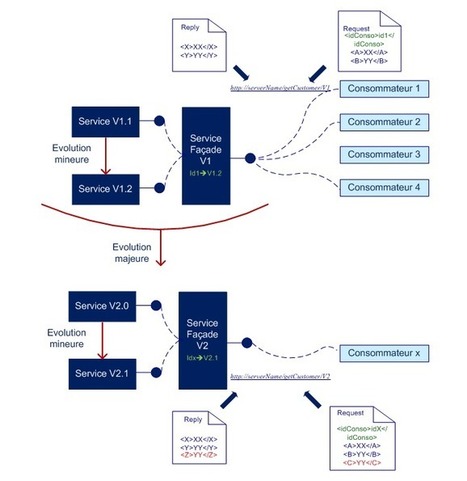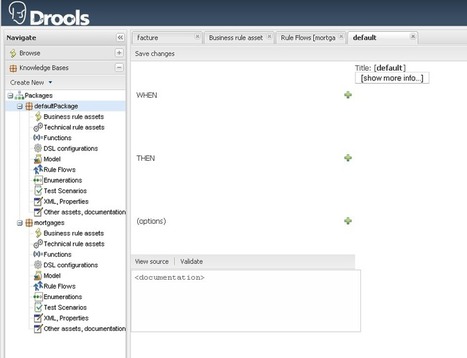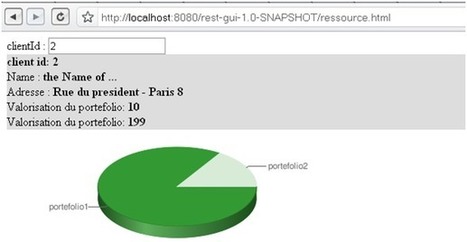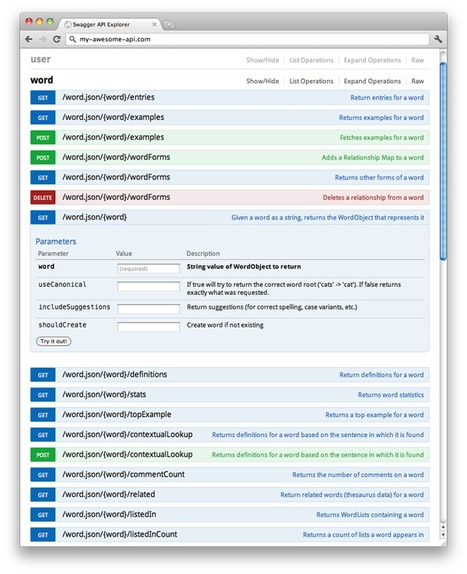 Your new post is loading...
 Your new post is loading...

|
Scooped by
Mickael Ruau
November 15, 2013 6:05 AM
|
Single worst strategic mistake you could ever make? Rewriting code from scratch.

|
Scooped by
Mickael Ruau
November 13, 2013 8:26 AM
|
Ward Cunningham a inventé les cartes CRC en s'inspirant d'une application de documentation d'architecture logicielle sous hypercard . Il les a présenté avec Kent Beck lors de la conférence OOPSLA de 1989.

|
Scooped by
Mickael Ruau
November 12, 2013 6:02 AM
|
So I’m going to define some concepts to flesh out an idea. This isn’t exactly a formalized theory or anything. It’s rather just a working lexicon of how I think about my application. This is a scale of system flexibility for a given future change. Or, put another way, here is a way of assessing how much effort on the part of the entire development/operations group doing X for the aforementioned user will be, from least to most significant. Users can do it themselves.An IT-level change is required (e.g. changing a config file, swapping out images, etc.)An architect/dev change is required to configuration (e.g. XML for an IoC container)A non-compiled source code change is required (e.g. you update the markup for a site but not the underlying code)An Open/Closed Principle Compliant source code change is required (basically adding new code).A localized tweak to existing code is required.A substantial change to existing code is required spanning various modules.

|
Scooped by
Mickael Ruau
November 4, 2013 3:10 PM
|
Kevlin Henney believes that it's time to revisit the thinking behind "Worse is Better" which is what he does in this interview with Noel Wurst.

|
Scooped by
Mickael Ruau
November 1, 2013 5:40 PM
|
If you are like me, in your career you came across Architects who want to homogenize every single application in the company : from the smallest web app to the biggest application.

|
Scooped by
Mickael Ruau
October 31, 2013 3:06 AM
|
Dans une implémentation SOA, un service n’a de sens que s’il est invoqué par plusieurs applications ou blocs applicatifs. Par conséquent, tout changement survenant sur un service impacte l’ensemble des consommateurs de ce service. Non seulement ces changements peuvent coûter chers, en plus, l’autonomie du service est un fondement de la mise en œuvre d’une architecture orientée services. L’autonomie se traduit par le fait que le service peut être modifié, déployé et maintenu indépendamment des consommateurs qui l’invoquent.

|
Scooped by
Mickael Ruau
October 26, 2013 6:14 AM
|
Another superb guest post is up on Martin Fowler's blog today. This one is about a topic that doesn't get a lot of coverage outside of DZone, Enterprise Integration. Here was a pointed introductory paragraph from the article: Preview...

|
Scooped by
Mickael Ruau
October 24, 2013 4:35 AM
|
In computer science, separation of concerns ( SoC) is a design principle for separating a computer program into distinct sections, such that each section addresses a separate concern. A concern is a set of information that affects the code of a computer program.

|
Scooped by
Mickael Ruau
October 18, 2013 1:53 PM
|
Lorsque l'on entend parler de moteur de règles, on a souvent tendance à y associer le mot "Drools". Pourquoi ce réflexe : Par habitude ? Pa

|
Scooped by
Mickael Ruau
October 18, 2013 10:36 AM
|
The guide is intended to help developers and solution architects design and build effective, high quality applications using the Microsoft platform and the .NET Framework more quickly and with less risk; it provides guidance for using architecture principles, design principles, and patterns that are tried and trusted.

|
Scooped by
Mickael Ruau
October 17, 2013 3:49 AM
|
“Small pieces loosely joined,” David Weinberger’s appealing theory of the Web, has much to say to programmers as well. It always inspires me to reduce the size of individual code components.

|
Scooped by
Mickael Ruau
October 15, 2013 4:47 PM
|
Il existe de plus en plus de services Webs, qui vous permettent de couvrir un bon nombre de problèmes récurrents. L’heure est de plus en plus à l’intégration de service, et l’interface technique est bien souvent constituée d’un peu d’échanges HTTP, avec parfois du Javascript côté client.

|
Scooped by
Mickael Ruau
October 7, 2013 5:34 AM
|
Scalable & Available Patterns for SuccessTuesday, March 8, 2011 1
|

|
Scooped by
Mickael Ruau
November 13, 2013 11:23 AM
|
DossierLe cloud : quels enjeux et quels rôles pour les DSI ?TechniqueRéussir l’urbanisation de son Système d’InformationComment ca marchePlus de 10 ans de projets de gestion des identités… et maintenant ?Rubrique a bracTests applicatifs sur environnements virtualisés avec Team Foundation Server

|
Scooped by
Mickael Ruau
November 12, 2013 9:09 AM
|
La méthode RACINES est une méthode informatique destinée à étudier la stratégie du système d'information. RACINES est un acronyme de RAtionalisation des Choix INformatiqu ES. Elle a pour but de définir des priorités d'informatisation par domaine dans le cadre d'un fonctionnement global futur, en tenant compte des budgets et des calendriers.

|
Scooped by
Mickael Ruau
November 4, 2013 3:11 PM
|
Brute force performance and scalability testing, also known as "load it up and see what happens," is expensive, slow, and fairly subjective.

|
Scooped by
Mickael Ruau
November 3, 2013 5:57 AM
|
Let us celebrate this venerable structural stalwart with a rousing tour of examples showing just how classes are grouped and protected within their loving confines. Supplying these specimens will be no Java weakling found huddled in an internet basement, but Apache's flagship software management tool, Maven itself. Specifically, the maven-core-3.0.5.jar has been casually selected as the lucky donor. The contents of these packages will be shown as spoiklin diagrams in which a circle represents a class, a straight line represents a dependency from a class drawn above to one drawn below and a curved line represents a dependency from a class drawn below to one drawn above. The colour of a class indicates the relative number package-dependency tuples (that is, transitive dependencies) of which it partakes: the redder, the more dependency tuples.

|
Scooped by
Mickael Ruau
October 31, 2013 3:07 AM
|
Lorsqu’on parle de ressource et de REST en général, on associe souvent la notion de services, une représentation XML ou JSON d’un résultat, d’une donnée…On ne pense que rarement à la notion de ressource comme pouvant retourner une IHM ou une portion d’IHM, c’est-à-dire, de la donnée mise en forme. Ici, l’idée est simple : utiliser des ressources REST – proposant une représentation HTML – pour agréger et construire une nouvelle IHM côté client, dans le navigateur.

|
Scooped by
Mickael Ruau
October 26, 2013 8:09 AM
|
Making Your PHP Application Easy to CustomizeJohn Mertic@2010 SugarCRM Inc. All rights reserved.

|
Scooped by
Mickael Ruau
October 24, 2013 7:43 AM
|
The Microsoft SQL Server 2012 System Views Map shows the key system views included in SQL Server 2012, and the relationships between them.

|
Scooped by
Mickael Ruau
October 24, 2013 4:02 AM
|
Swagger is a specification and complete framework implementation for describing, producing, consuming, and visualizing RESTful web services. The overarching goal of Swagger is to enable client and documentation systems to update at the same pace as the server. The documentation of methods, parameters, and models are tightly integrated into the server code, allowing APIs to always stay in sync. With Swagger, deploying managing, and using powerful APIs has never been easier.

|
Scooped by
Mickael Ruau
October 18, 2013 1:36 PM
|
Un modèle doit être à la fois sobre (principe d’économie) et pertinent (principe d’efficacité). La justesse de ces principes résulte de la complexité inhérente au réel et de notre incapacité à le penser entièrement. Il faut percevoir cette incapacité non comme un manque, un défaut, mais comme une force : elle est condition nécessaire de l'action et de la formation du « coup d’œil », de même que l'imperfection de notre mémoire est condition nécessaire de notre capacité à créer des concepts (cf.Les embarras de la complication).
Pour sortir de l'embarras, il faut assumer et cultiver la simplicité de la pensée. On peut aussi s'appuyer sur quelques outils méthodologiques : modèle en couches ; croisement des découpages ; raisonnement probabiliste ; élaboration de la pertinence par des consultations et validations, etc.
On rencontre en informatique des difficultés d'origine technique : par abus de langage, on les baptise du terme « complexité ». Elles ne relèvent pas exactement de la présente étude, mais il est intéressant de les examiner (cf. "Complexité" en informatique).

|
Scooped by
Mickael Ruau
October 18, 2013 10:30 AM
|
Proven practices for predictable results.

|
Scooped by
Mickael Ruau
October 15, 2013 4:47 PM
|
Voici la suite d’un retour d’expériencessur différentes API et outils webs que j’utilise pour mes clients Analyser le parcours client et détecter les circuits des visiteursGéolocaliser l’adresse IP de vos visiteursIntégrer les commentaires des visiteursPrendre en compte les idées/suggestions de vos visiteursAccepter des paiements par Carte bancaire

|
Scooped by
Mickael Ruau
October 13, 2013 1:00 PM
|
Quand on en vient à l’interaction entre des machines informationnelles, revient toujours et systématiquement la question du “semantic gap”, qui est une façon condensée de dire : “comment deux machines peuvent-elles se comprendre sans se connaître a...
|
 Your new post is loading...
Your new post is loading...
 Your new post is loading...
Your new post is loading...



























The old mantra build one to throw away is dangerous when applied to large scale commercial applications.
If you are writing code experimentally, you may want to rip up the function you wrote last week when you think of a better algorithm. That's fine. You may want to refactor a class to make it easier to use. That's fine, too.
But throwing away the whole program is a dangerous folly, and if Netscape actually had some adult supervision with software industry experience, they might not have shot themselves in the foot so badly.